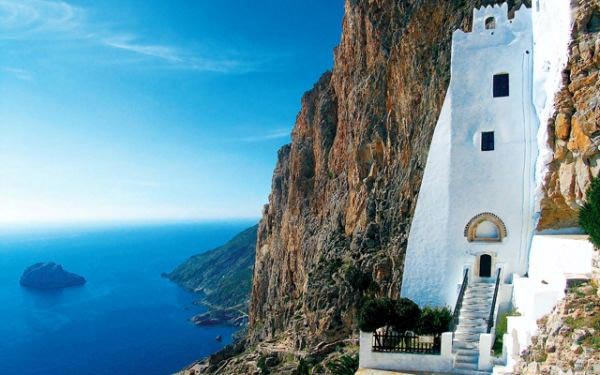
This Monastery is situated on the southern and sheer coast of Amorgos. It is 300m high so it is visible only by the sea that lies deep under the feet of the rocks. The image of the snow-white and simple Monastery fits perfectly with the colourful but rough rocks near it.
It is only possible to see the white volumes as well as the strong linear outlines of the building only if you come close to it. Also, the sun makes these shapes look as if they are part of a multi-level surface.
The length of the building is 40m and its width is no more than 5m. As its breadth is not very broad, the eight levels – “floors” of the building do not coincide anywhere. There are narrow stairs, others made of stone, and others built or curved on the rock which leads to the eight “floors”. There are also byzantine-type arches and arrows, or pointed arches of the Venetian times (1296-1537) which are made of stone or tufa from Milos, as well as wooden beams and timber frames. All of them are part of the complicated internal space of the Monastery.
The numerous cells of the monks, the Refectory, the cooking place, the ovens, the warehouses, the treading tanks, the cisterns and the wells are all wedged into the rock that is being transformed into a functional building element which is an admirable sample of the anonymous, functional, folk architecture.
In the small, single-room and arched small church, you can also find the live evidence of what local residents have been disseminating orally about the origin of the icon from Hozova (or Hozovo) of Palestine: the two inscribed icons of Panagia Hozoviotissa and the chisel of its head craftsman which is made of iron are a real evidence of the narration “about the exact position Panagia (Virgin Mary) ordered for her temple to be built”. Also, the silver, inscribed flabbelum of the church is an important physical evidence for the story of the foundation of the Monastery, which, as the flabbelum indicates, “was renovated by the Great Alexios Komninos the First” the Emperor of Byzantium (1081 – 1118).
The name “Hozoviotissa”, which is an undeniable evidence of the historic core of the local, oral tradition, was created from the linguistic corruption of “Hozovitissa” or “Kozivitissa”, which comes from the place name “Hoziva” or “Koziva” in the Holy Lands, which is a place at Wadi Qilt of Jeriho. There had been important Christian Orthodox monasteries since the first Christian times, according to written data of the Byzantium times.
At the times of Iconomachy, in the 8th and 9th century, according to local, oral narrations, the icon arrived miraculously, by the sea, at the bay of Saint Anna, near the Monastery.
Telephone number of the Monastery: 22850 71274
Source of the text: the Ministry of Culture of Greece













